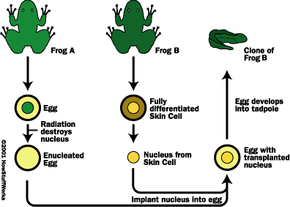Producing Clones: Animal Kingdom
Plants are not the only organisms that can be cloned naturally. The unfertilized eggs of some animals (small invertebrates, worms, some species of fish, lizards and frogs) can develop into full-grown adults under certain environmental conditions -- usually a chemical stimulus of some kind. This process is called parthenogenesis, and the offspring are clones of the females that laid the eggs.
Another example of natural cloning is identical twins. Although they are genetically different from their parents, identical twins are naturally occurring clones of each other.
Advertisement
Scientists have experimented with animal cloning, but have never been able to stimulate a specialized (differentiated) cell to produce a new organism directly. Instead, they rely on transplanting the genetic information from a specialized cell into an unfertilized egg cell whose genetic information has been destroyed or physically removed.
In the 1970s, a scientist named John Gurdon successfully cloned tadpoles. He transplanted the nucleus from a specialized cell of one frog (B) into an unfertilized egg of another frog (A) in which the nucleus had been destroyed by ultraviolet light. The egg with the transplanted nucleus developed into a tadpole that was genetically identical to frog B.
While Gurdon's tadpoles did not survive to grow into adult frogs, his experiment showed that the process of specialization in animal cells was reversible, and his technique of nuclear transfer paved the way for later cloning successes.
